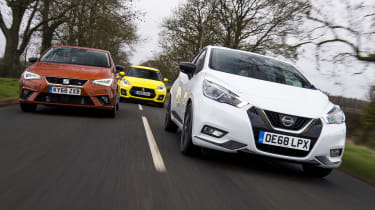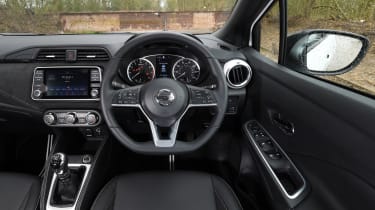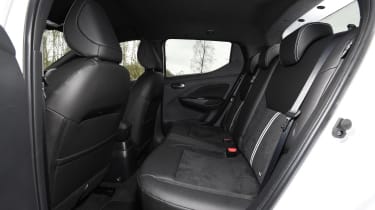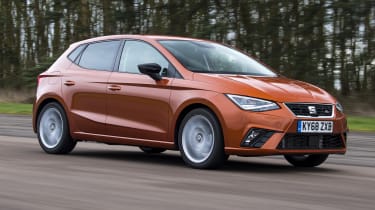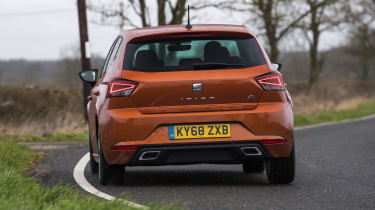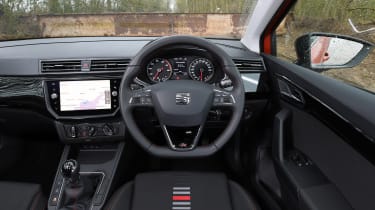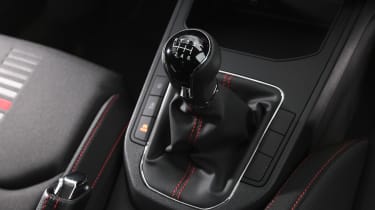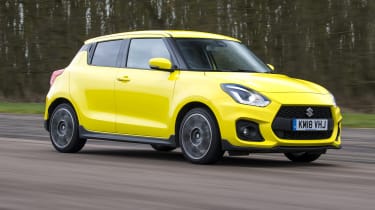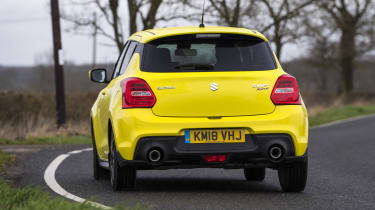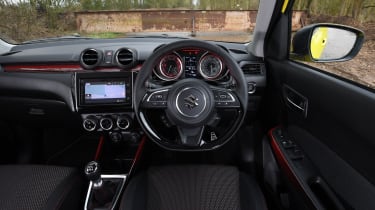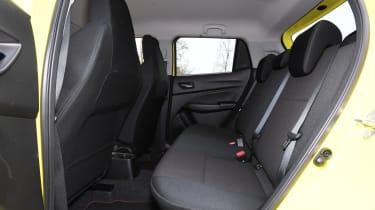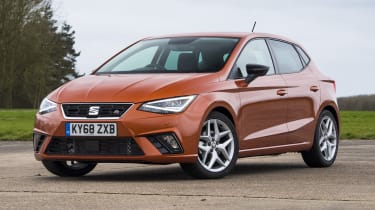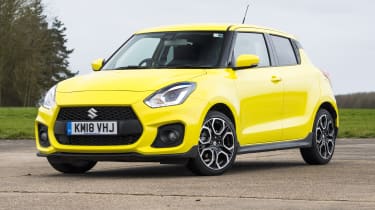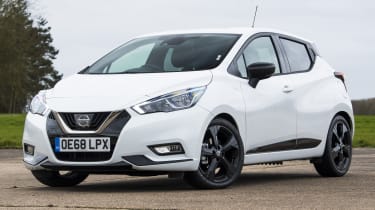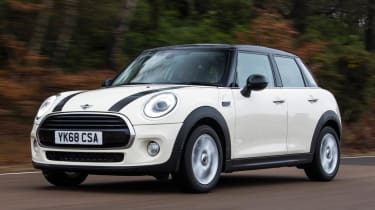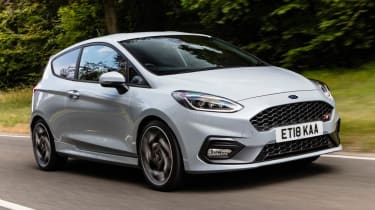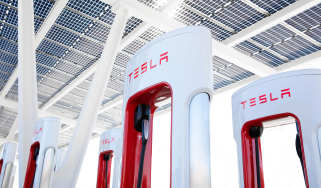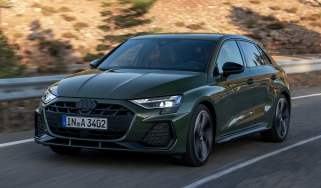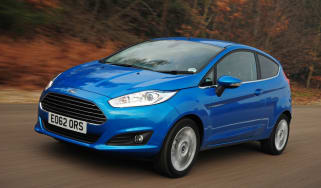Nissan Micra N-Sport vs SEAT Ibiza FR Sport vs Suzuki Swift Sport
The new Nissan Micra N-Sport aims to turn up the heat in the warm hatch market. We test it against rivals from SEAT and Suzuki
Superminis have been topping sales charts in Britain for decades, and with good reason: they offer a brilliant balance between the most important features buyers look for in a new model at this price point.
They need to be affordable, yet most have room for a family and are cheap to run as well. There’s another reason that they are so popular, though; thanks to their light kerbweights, these small cars can be great fun to drive, too.
The hot hatch is the ultimate version of the modern supermini, and our current favourite is the Ford Fiesta ST. But models like that are more expensive to buy, run and insure – not to mention much more hardcore to drive – so some manufacturers offer warmed-up versions to better suit the majority of customers.
Nissan is the latest to do this, hoping to appeal to keen drivers by boosting its updated Micra range with an N-Sport model featuring a new 115bhp engine. But the car faces stiff competition from SEAT’s Ibiza FR, one of our favourite choices in this class.
Then there’s the Suzuki Swift Sport, which has an even more potent 1.4-litre engine and a chassis tweaked for fun, giving extra enthusiast appeal. The Swift is also cheaper. But which is the one to go for?
Nissan Micra N-Sport
| Nissan Micra DIG-T 117 N-Sport | |
| Price: | £19,010 |
| Engine: | 1.0-litre 3cyl petrol, 115bhp |
| 0-60mph: | 10.3 seconds |
| Test economy: | 47.0mpg/10.3mpl |
| CO2: | 114g/km |
| Annual road tax: | £140 |
Nissan’s updated Micra was launched earlier in the year, and the range now includes this slightly fruitier N-Sport model, powered by a 115bhp 1.0-litre turbocharged petrol engine. It costs £19,010.
More reviews
Car group tests
In-depth reviews
Road tests
- Nissan Micra (Mk2, 1992-2002) icon review
- New Nissan Micra N-Sport 2019 review
- Long-term test review: Nissan Micra
- Nissan Micra Acenta 1.0 petrol 2017 review
Used car tests
Design & engineering
The Japanese brand has worked on improving areas that were lacking in the pre-facelift Micra, starting with the engine. This new 1.0-litre motor replaces the previous 0.9-litre unit, which left a lot to be desired, and in the N-Sport the engine produces a competitive 115bhp.
In addition, the company has fitted a fresh NissanConnect infotainment system, and cars with the latest motor feature 10mm lower suspension and revised steering to boot. However, the Micra hasn’t undergone a fundamental change. The basic suspension layout is the same, with MacPherson struts at the front and a torsion-beam layout at the rear. Still, N-Sport models do benefit from a firmer set-up that’s intended to improve the car’s handling.
The interior hasn’t received too many changes, either, and the design is pretty similar to its predecessor’s, despite the updated tech. There are soft-touch plastics used in a smattering of areas, but mostly material quality is average and it feels plasticky, even if everything seems solidly built. It’s a far cry from Micras of old, but the Ibiza still feels more upmarket with its classier look. There’s less cheap-looking plastic on display than in the Swift, though.
Standard equipment on the high-spec N-Sport model includes 17-inch alloy wheels, the new infotainment system that features Android Auto and Apple CarPlay, a rear-view camera, tinted windows, keyless go and part-Alcantara seats.
Driving
Despite its exterior styling, this warmed-up Micra doesn’t have the bite to back up its slightly more potent bark. The main problem is grip; this is one of the things that is lacking next to its competitors.
Push into a corner hard and the Nissan starts to understeer quite heavily and sooner than its rivals, yet if you back off it gets unsettled at the rear. It also doesn’t communicate to the driver what is going on; the steering is too numb, so the Micra can’t compete with the precision of the SEAT and Suzuki. Yet it’s not totally without merit, because the body control allows enough movement but not too much.
These cars aren’t all about entertaining their driver, because they also need to be comfortable enough to be used every day. While the Micra rides smoothly, it is only about on par with the much more fun-to-drive Swift Sport, while the Ibiza beats both of them for comfort.
Despite its larger engine than before, the Nissan still feels underpowered, because its power delivery is all in the mid-range. At low revs it feels very sluggish when you put your foot down and it struggles to add speed, while at the top end it’s lifeless, so there’s no fun to be had there, either. Also, the spongy gearchange isn’t as nice as either of its rivals’.
Both the Micra and Ibiza fell some way behind the more powerful Swift Sport in our performance tests, yet the Nissan was also slow next to the SEAT. It took 10.3 seconds to go from 0-60mph, while the Ibiza clocked 9.2 seconds. The Swift stormed away with a 7.7-second time. In top gear from 50-70mph, the Micra was three seconds slower than the Spanish model, while the Suzuki was nearly twice as quick as the Nissan. The new engine is certainly better than the old 0.9, but it still can’t match the Ibiza’s 1.0 TSI for smoothness, performance or entertainment.
Practicality
A 300-litre boot puts the Micra in between its rivals here. The SEAT has 355 litres, placing it among the more spacious cars in this class, while the Suzuki’s 265 litres is smaller than average. Still, for day-to-day tasks the Nissan should have enough room for most people; only long weekends away will really test it.
It’s a similar story when it comes to legroom, because the Micra has an average amount of space in the back, enough for all but tall adults to sit reasonably comfortably. Still, its Japanese rival is closer here, because even though the Swift is a little more compact, there is still an acceptable level of room for passengers.
Ownership
Nissan finished fourth in the makers’ chart of our Driver Power 2018 satisfaction survey, while SEAT was 14th and Suzuki 11th. In the dealer poll, Nissan and SEAT came 25th and 23rd respectively, which wasn’t great. Suzuki ranked fourth.
Safety equipment is a strong point on the Micra, though, with all models in the range featuring autonomous braking and lane-keep assist. You can also upgrade with the £600 Vision+ Pack, which adds a 360-degree camera with moving object detection and blind spot warning.
Running costs
The Micra managed 47.0mpg on test, which beat the Ibiza’s 44.4mpg and the Swift’s 42.8mpg results. That works out at £1,413 in annual fuel costs for the Nissan (over 12,000 miles), while the SEAT works out at £1,495 at the pumps and the Suzuki a little more, at £1,551.
Many people will buy these warm hatches due to the high insurance bills of a full-on hot hatch, and the Ibiza is the winner in that case. It will set our example driver back £385 a year, while the Micra and Swift will cost £390 and £478 respectively. Given the strong performance of the Suzuki – and the opposite in the Micra – the Nissan’s insurance premium looks a little high, but overall the car is pretty cheap to run.
Testers’ notes
“The Nissan’s driving position feels awkward. Its ergonomics aren’t great; the other cars feel more natural in this respect. We found it harder to get comfortable and the wheel position is too low.”
SEAT Ibiza FR Sport
| SEAT Ibiza 1.0 TSI 115 FR Sport | |
| Price: | £19,320 |
| Engine: | 1.0-litre 3cyl petrol, 113bhp |
| 0-60mph: | 9.2 seconds |
| Test economy: | 44.4mpg/9.8mpl |
| CO2: | 108g/km |
| Annual road tax: | £140 |
The SEAT Ibiza is one of the best superminis around and this 113bhp version is a top choice within the range, offering a good combination of performance and economy. In FR Sport trim (the car in our pictures is an FR) it costs from £19,320.
Design & engineering
SEAT has built the Ibiza on the VW Group’s versatile MQB A0 platform, which uses clever packaging to maximise interior space, while providing an accomplished base chassis for the brand’s engineers to work from.
It has MacPherson-strut front suspension and a torsion beam at the rear, just like the Micra, and as with the Nissan, the FR Sport also has a stiffer set-up than other Ibiza models. This makes less difference to the ride and handling than you might imagine, however. The larger alloy wheels fitted to this version have more of an impact on the way the car drives compared with lesser Ibiza trim levels.
The 18-inch rims are standard, along with suede seats, sportier exterior styling, LED headlights, climate and cruise control, sat-nav and even a digital instrument cluster, which is excellent for this class. It’s a shame that parking sensors are a £225 option on the Ibiza, despite being standard on the Micra (the Swift doesn’t have them, but it does feature a reversing camera, which isn’t available on the SEAT).
Of the three cars on test, the Ibiza has the best interior, thanks to its plush and comfortable seats, a clean dash design and soft-touch materials in the right places to add perceived quality. It also helps that the infotainment system looks more modern and is easier to use than either of its rivals’ set-ups.
Driving
Like other MQB-based superminis, the Ibiza is very grown-up. There are a few reasons for this, the main one being how good it is on the motorway. Many superminis can feel out of their depth here, because they are built with cost-cutting in mind, resulting in reduced soundproofing, while their engines are small. But the SEAT is quiet at high speed.
The other cars are good in one way or another; the Micra’s engine is very quiet and the Swift has supportive seats that help on long trips, but the Ibiza is more refined and more comfortable than its rivals. While its relatively large alloy wheels can crash into potholes, which is unpleasant, on the whole it rides smoothly, with the harsher suspension movements better damped than in either of its competitors.
It also has the driver appeal we’re looking for in this test. While it might not be able to compete with the Swift’s astonishing pace, the 1.0-litre engine is great. It has a more even spread of power than the Micra’s motor, and the manual shift is slicker, too, although the Suzuki’s is more satisfying still.
The Ibiza was more than a second faster from 0-60mph than the Micra in our acceleration tests, and while it was 0.6 seconds slower from 30-50mph in fourth gear than the Nissan, it was 0.1 seconds quicker in the same exercise in third gear, even though the two cars produce the same 200Nm of torque.
Both were left trailing by the Swift Sport in every test. Its 230Nm output helped it go from 50-70mph in sixth in 6.6 seconds. The Ibiza clocked 11.0 seconds and the Micra took 14.0 seconds in this task.
The Ibiza’s steering could do with more life, but at least it’s accurate, and the chassis is more consistent than the Micra’s, which adds confidence. SEAT’s hatch has plenty of grip as well. All of these factors add to the grown-up feel. The only small weak spot was its performance for the price, because the Swift Sport put it to shame in every straight-line test.
Practicality
However, the Ibiza is much more practical, and the roomy cabin adds to its expensive feel. The SEAT’s 355-litre boot is the first indication of this, because it’s 55 litres up on the Micra’s and 90 litres larger than the Swift’s load capacity.
There’s enough room in the back seats for adults, although taller passengers might complain a little about legroom behind a lofty driver. It’s the same case in all three models, though, and since the Ibiza has such a big boot as well, it’s easily the most versatile of these hatches. There’s a large central cubby for your phone and good-sized door bins, too.
Ownership
SEAT ranked 14th in the makers’ chart of our Driver Power 2018 survey, which was 10 places behind Nissan and three behind Suzuki; the Japanese cars have the advantage for owner satisfaction. However, much of the Ibiza’s make-up is also used elsewhere in the SEAT range, where it’s considered proven technology.
Safety equipment includes six airbags and autonomous emergency braking, but the Ibiza is missing lane-keep assist, which is standard on both of its rival superminis here.
Running costs
Low CO2 emissions of 108g/km mean the Ibiza sits in the 25 per cent Benefit-in-Kind (BiK) tax bracket for company car drivers and will cost a lower-rate earner £956 a year in tax. Emissions of 114g/km place the Micra in the 26 per cent bracket and give a £977 annual company car tax bill. The Swift’s 29 per cent rating makes it the most expensive business choice here, with £1,060 annual BiK contributions.
The Ibiza sat in between its rivals for fuel economy, returning 44.4mpg during our test. All three models achieved respectable figures, though, because mid-40s is about what you should expect from a petrol supermini, or a bit higher if you do more motorway miles.
Testers’ notes
“The Ibiza has very light controls; the clutch pedal, gearshift and steering are all designed for ease of use. However, it doesn’t detract from the fun, because it’s fast and accurate enough to drive.”
Suzuki Swift Sport
| Suzuki Swift Sport | |
| Price: | £17,499 |
| Engine: | 1.4-litre 4cyl petrol, 138bhp |
| 0-60mph: | 7.7 seconds |
| Test economy: | 42.8mpg/9.4mpl |
| CO2: | 125g/km |
| Annual road tax: | £140 |
The Swift Sport is a bit of an outsider in this test because it has extra power and a more focused chassis than its rivals. But thanks to a £1,000 discount currently on offer from Suzuki, it costs just £17,499. The Sport is its own model with no other trim levels.
Design & Engineering
While many superminis share platforms with other brands, the Swift stands alone, although its sister car, the Baleno, also uses Suzuki’s ‘Heartect’ architecture. This platform has a big focus on keeping weight down, and the cars that use it are consistently among the lightest models in their class – and it’s the same story here.
The Swift Sport differs from the standard car and its rivals here in a few key ways, the main one being a larger 1.4-litre BoosterJet turbo petrol engine. With 138bhp, it’s the most powerful model here by a big margin, and the Swift is also the lightest of the trio, at just 975kg; the others are more than 1,100kg. That means a high power-to-weight ratio and excellent performance, although we’ll discuss that more below.
Suzuki has also tweaked the suspension to reduce body roll in corners and increase agility, as well as fitting larger wheels, a bodykit and sports seats. The lurid Championship Yellow paint is an eye-catching option only for the Sport, too. It’s a no-cost extra, but many customers will be relieved that there are some subtler colours available as well.
The seats are joined by a few sporty styling add-ons on the standard equipment list, along with sat-nav, smartphone connectivity, adaptive cruise control, AEB and keyless go.
The Swift feels well built, but material quality is poor, especially compared with the SEAT. Hard plastics feature everywhere inside and even though the seats are supportive and quite comfortable, they look drab. At least Suzuki has added some visual flair to the dashboard for the Sport version with red and black detailing.
Driving
What the Swift lacks in maturity next to the grown-up Ibiza in particular, it makes up for by being good fun to drive. The most immediately impressive aspect of the Swift Sport is its engine, which is incredibly strong and feels more powerful than its modest 138bhp figure suggests. In our performance tests it managed a 0-60mph time of 7.7 seconds, which was well ahead of both competitors. It was similarly strong in gear, and was well over a second faster than both rivals in all of our tests.
It’s just a shame that the Suzuki’s engine isn’t more characterful, though. At least the transmission adds some personality, because you can enjoy going through the gears thanks to the slick, mechanical-feeling six-speed manual, which is the best box here.
The Swift is fun in corners, too, because it has lots of grip and is light on its feet, which means it’s responsive to inputs. The steering is a bit heavy and there’s not a lot of feel, although none of these models has a particularly engaging steering set-up.
That low kerbweight also has benefits for the quality of the ride, because despite its large wheels, the Swift is pretty comfortable. It deals with potholes better than the Micra and the Ibiza, although roads that are consistently rough do start to upset the Suzuki’s composure. Despite a few flaws, the Swift is much closer to being a proper hot hatch than its rivals, so it remains the enthusiast’s choice in this test.
Practicality
Part of why the Swift is so light is that it’s quite a bit smaller than most other superminis, at 3,890mm long by 1,735mm wide. The Micra and Ibiza are 3,999mm and 4,059mm long respectively, to give a sense of scale. While that means the Suzuki is easy to park, it does limit interior space and there’s less leg and headroom here than in both rivals.
Similarly, the boot is smaller than the others’ at 265 litres, and it’s a less useful shape as well. While it’s big enough for some shopping, it’s ultimately pretty small and dampens the car’s everyday appeal.
Ownership
Suzuki finished in an average 11th in our Driver Power 2018 makers’ table,but the Japanese brand does have a good reputation for building reliable models, so there’s no cause for concern with the Swift. A dealer ranking of fourth is good news as well.
Standard safety kit is the best in this test, with autonomous braking, adaptive cruise, high-beam assist and lane-keep assist all included as standard.
So even though the Swift scored lower than both of its rivals in its Euro NCAP crash test, at four stars, if you look closer at the ratings, the reason for this was that lower-spec models in Europe miss out on crucial kit that’s all present on the Sport. So in practice, the Suzuki should be just as safe.
Running costs
Depreciation isn’t a strong point for any of these models, but our experts predict that the Suzuki will lose the least value over three years, at £10,688.
However, because it’s the cheapest car to buy, it won’t be worth as much as the SEAT; the Swift has an estimated residual of £6,811, or 38.9 per cent, but the Ibiza is set to hold on to 40 per cent of its list price, losing £11,594, so it will be worth £7,726. The Micra loses £12,533 at 34.1 per cent, with a value of £6,477.
Given the performance on offer, the Swift’s 42.8mpg return is pretty reasonable and not that far behind its smaller-engined rivals’, but be aware that it will also cost quite a bit more to insure (nearly £100 a year more for our example driver).
Testers’ notes
“We wish the Swift Sport were livelier in corners. The previous model was more fun, despite being less powerful. But the chassis is capable and the gearchange sweet, even if the engine could be better.”
Verdict
First place: Seat Ibiza FR Sport
The Ibiza makes the most convincing case here. It’s a superb all-rounder and the best choice for most buyers. For a start, it’s the most practical car, but it’s also full of hi-tech equipment and is cheap to run. The engine is punchy and entertaining, and the grippy chassis and precise steering mean it’s also worthy of the FR Sport trim’s performance aspirations, despite not being a full hot hatch. The Ibiza delivers a decent level of comfort, too
Second place: Suzuki Swift Sport
If you’re looking for a hotter supermini on a budget, the Swift Sport ought to be on your shortlist. It really makes the most of its modest 138bhp, thanks to its low kerbweight, which also means the Suzuki is agile without being too unforgiving. It doesn’t have the wide appeal of the Ibiza, because it’s limited on practicality and isn’t as cheap to run, but it’s more fun than both of its rivals and has a charming character.
Third place: Nissan Micra N-Sport
Don’t let the N-Sport branding fool you, because the Micra’s 1.0-litre engine is a disappointment. It’s better than the previous 0.9, but is still slow and not much fun to exploit. The Nissan isn’t as enjoyable as either rival, nor as well equipped. It also trails the Ibiza for practicality and, despite good fuel economy, it will cost more to run, too. While it’s an improvement, the Micra still lags behind its rivals.
Also consider...
New: MINI Cooper
Model: MINI Cooper Classic five-doorPrice: £18,330Engine: 1.5-litre 3cyl, 136bhp
The MINI is among the most enjoyable superminis to drive and has plenty of performance, yet comes in within budget next to its rivals in this test. You’ll have to add optional extras to match them on kit, but whatever you spend, the MINI is brilliant fun.
Used: Ford Fiesta ST (2018)
Model: Ford Fiesta ST Price: £19,500 Engine: 1.5-litre 3cyl, 197bhp
Buy used and a Ford Fiesta ST is within reach, even in top-spec ST-3 form. We found one from last year with just 2,600 miles for £19,500. That’s cheap for one of the best hot hatches ever. It’s rapid and handles well, but the ride is very firm.
Figures
| SEAT Ibiza 1.0 TSI 115 FR Sport | Suzuki Swift Sport | Nissan Micra DIG-T 117 N-Sport | |
| On the road price/total as tested | £19,320/£19,320 | £17,499/£17,499 | £19,010/£19,010 |
| Residual value (after 3yrs/36,000) | £7,726/40.0% | £6,811/38.9% | £6,477/34.1% |
| Depreciation | £11,594 | £10,688 | £12,533 |
| Annual tax liability std/higher rate | £956/£1,912 | £1,060/£2,120 | £977/£1,954 |
| Annual fuel cost (12k/20k miles) | £1,495/£2,492 | £1,551/£2,585 | £1,413/£2,354 |
| Insurance group/quote/road tax cost | 14/£385/£140 | 35/£478/£140 | 11/£390/£140 |
| Cost of 1st/2nd/3rd service | £324 (2yrs) | £970 (3yrs) | £199/£269/£199 |
| Length/wheelbase | 4,059/2,564mm | 3,890/2,450mm | 3,999/2,525mm |
| Height/width | 1,444/1,780mm | 1,495/1,735mm | 1,455/1,743mm |
| Engine | 3cyl in-line/999cc | 4cyl in-line/1,373cc | 3cyl in-line/999cc |
| Peak power/revs | 113/5,000 bhp/rpm | 138/5,500 bhp/rpm | 115/5,250 bhp/rpm |
| Peak torque/revs | 200/2,000 Nm/rpm | 230/2,500 Nm/rpm | 200/1,750 Nm/rpm |
| Transmission | 6-speed man/fwd | 6-speed man/fwd | 6-speed man/fwd |
| Fuel tank capacity/spare wheel | 40 litres/repair kit | 37 litres/repair kit | 41 litres/repair kit |
| Boot capacity (seats up/down) | 355/823 litres | 265/947 litres | 300/1,004 litres |
| Kerbweight/payload/towing weight | 1,149/511/1,200kg | 975/470kg/N/A | 1,100/460/1,200kg |
| Turning circle | 10.6 metres | 10.2 metres | 10 metres |
| Basic warranty (miles)/recovery | 3yrs (60,000)/2yrs | 3yrs (60,000)/1yr | 3yrs (60,000)/3yrs |
| Driver Power manufacturer/dealer pos. | 14th/23rd | 11th/4th | 4th/25th |
| NCAP: Adult/child/ped./assist/stars | 95/77/76/60/5 (2017) | 88/75/69/44/4 (2017) | 91/79/79/72/5 (2017) |
| 0-60/30-70mph | 9.2/9.2 secs | 7.7/6.1 secs | 10.3/9.4 secs |
| 30-50mph in 3rd/4th | 4.3/6.4 secs | 3.1/4.4 secs | 4.4/5.8 secs |
| 50-70mph in 5th/6th | 8.1/11.0 secs | 5.5/6.6 secs | 7.9/14.0 secs |
| Top speed/rpm at 70mph | 121mph/2,300rpm | 130mph/2,500rpm | 121mph/2,200rpm |
| Braking 70-0/60-0/30-0mph | 50.3/36.7/9.2 metres | 50.6/36.7/9.5 metres | 51.0/38.6/9.9 metres |
| Noise outside/idle/30/70mph | 71/43/65/75dB | 62/46/69/77dB | 72/43/66/76dB |
| Auto Express econ. (mpg/mpl)/range | 44.4/9.8/391 miles | 42.8/9.4/348 miles | 47.0/10.3/424 miles |
| WLTP combined mpg | 46.3-50.4mpg | 47.1-47.1mpg | 47.9-47.9mpg |
| WLTP combined mpl | 10.2-11.1mpl | 10.4-10.4mpl | 10.5-10.5mpl |
| Actual/claimed CO2/tax bracket | 147/108g/km/25% | 152/125g/km/29% | 139/114g/km/26% |
| Airbags/Isofix/park sensors/camera | Six/yes/£225/no | Six/yes/no/yes | Six/yes/yes/yes |
| Auto box/lane-keep/blind spot/AEB | £1,100/no/no/yes | No/yes/no/yes | No/yes/no/yes |
| Clim/cruise ctrl/leather/heated seats | Yes/yes/suede/no | Yes/adaptive/no/no | A/C/yes/synthetic/no |
| Met paint/LEDs/keyless/power tailgate | Yes/yes/no/no | Yes/yes/yes/no | £575/no/yes/no |
| Nav/digital dash/DAB/connected apps | Yes/yes/yes/yes | Yes/no/yes/no | No/no/yes/no |
| Wireless charge/CarPlay/Android Auto | No/yes/yes | No/yes/yes | No/yes/yes |
